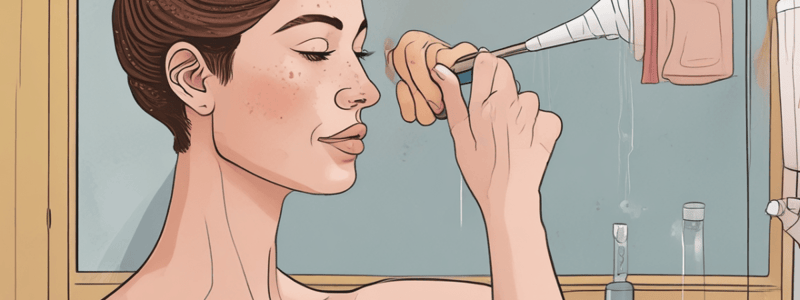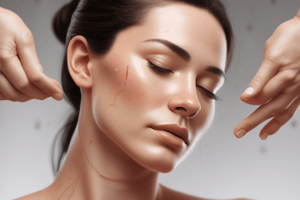Podcast
Questions and Answers
What percentage of teenagers are affected by acne vulgaris?
What percentage of teenagers are affected by acne vulgaris?
- 60%
- 85% (correct)
- 90%
- 50%
What is believed to activate acne formation during stress periods?
What is believed to activate acne formation during stress periods?
- Increased output of hormones from pancreas
- Increased output of hormones from adrenal glands (correct)
- Increased output of hormones from pituitary glands
- Increased output of hormones from thyroid glands
What is an example of a medication that can cause acne?
What is an example of a medication that can cause acne?
- Antibiotics
- Anti-inflammatory drugs
- Barbiturates (correct)
- Painkillers
What is the goal of Physiotherapy treatment of acne vulgaris?
What is the goal of Physiotherapy treatment of acne vulgaris?
What is a dietary factor that can increase the chances of developing acne?
What is a dietary factor that can increase the chances of developing acne?
What is a hormonal treatment for acne in females?
What is a hormonal treatment for acne in females?
What is a type of treatment for acne that uses a specific type of light?
What is a type of treatment for acne that uses a specific type of light?
What percentage of adult women suffer from adult acne?
What percentage of adult women suffer from adult acne?
What is the primary goal of the UVR treatment in the context of Alopecia Areata?
What is the primary goal of the UVR treatment in the context of Alopecia Areata?
What is the typical age range affected by Alopecia Areata?
What is the typical age range affected by Alopecia Areata?
What is the role of T cell lymphocytes in Alopecia Areata?
What is the role of T cell lymphocytes in Alopecia Areata?
What is the primary cause of Alopecia Areata?
What is the primary cause of Alopecia Areata?
What is the term for the loss of hair from the scalp in patches?
What is the term for the loss of hair from the scalp in patches?
What is the prognosis for patients with Alopecia Areata?
What is the prognosis for patients with Alopecia Areata?
What is the purpose of the He-Ne laser treatment in the context of Alopecia Areata?
What is the purpose of the He-Ne laser treatment in the context of Alopecia Areata?
What is the aim of the physiotherapy treatment for Alopecia Areata?
What is the aim of the physiotherapy treatment for Alopecia Areata?
What is the primary goal of treatment for skin involvement in conditions like vitiligo?
What is the primary goal of treatment for skin involvement in conditions like vitiligo?
What is the typical age range for the onset of dermatomyositis in adulthood?
What is the typical age range for the onset of dermatomyositis in adulthood?
What is the estimated incidence of vitiligo in the general population?
What is the estimated incidence of vitiligo in the general population?
What is the female to male ratio of dermatomyositis?
What is the female to male ratio of dermatomyositis?
What is the main characteristic of segmental pattern vitiligo?
What is the main characteristic of segmental pattern vitiligo?
What is the primary mechanism of muscle damage in dermatomyositis?
What is the primary mechanism of muscle damage in dermatomyositis?
What is the expected success rate of PUVA therapy in repigmenting the skin?
What is the expected success rate of PUVA therapy in repigmenting the skin?
What is the purpose of psoralen in PUVA therapy?
What is the purpose of psoralen in PUVA therapy?
What is the most common systemic manifestation of dermatomyositis?
What is the most common systemic manifestation of dermatomyositis?
What is the primary goal of physical therapy management in dermatomyositis?
What is the primary goal of physical therapy management in dermatomyositis?
Who may benefit from skin grafting as a treatment for vitiligo?
Who may benefit from skin grafting as a treatment for vitiligo?
What is the characteristic skin rash associated with dermatomyositis?
What is the characteristic skin rash associated with dermatomyositis?
What is a common symptom of vitiligo?
What is a common symptom of vitiligo?
What is the potential complication of respiratory muscle weakness in dermatomyositis?
What is the potential complication of respiratory muscle weakness in dermatomyositis?
What is the typical duration of PUVA therapy to achieve repigmentation?
What is the typical duration of PUVA therapy to achieve repigmentation?
What is the typical location of muscle weakness in dermatomyositis?
What is the typical location of muscle weakness in dermatomyositis?
Flashcards are hidden until you start studying
Study Notes
Skin Disorders
Acne Vulgaris
- A skin disease caused by changes in the pilosebaceous units (hair follicles and sebaceous gland)
- Commonly occurs during adolescence, affecting more than 85% of teenagers, and frequently continues into adulthood
- Causes:
- Family/genetic history
- Hormonal activity (menstrual cycle, puberty)
- Inflammation, skin irritation, or scratching
- Stress
- Hyperactive sebaceous glands
- Accumulation of dead skin cells blocking pores
- Bacteria in pores
- Use of anabolic steroids
- Certain medications (barbiturates, androgen)
- Diet (high consumption of chocolates)
- Treatment:
- Oral antibiotics
- Topical antibiotics
- Hormonal treatment (for females)
- Physiotherapy:
- Goals:
- Obtain desquamation of skin
- Increase vascularity
- Reduce number of micro-organisms
- Improve general health and hygiene
- Methods:
- UVR
- Laser (He-Ne laser, 632.8nm wavelength)
- Goals:
Alopecia Areata
- Defined as premature loss of hair, sometimes leading to total loss of hair from the body
- Causes:
- Autoimmune disorder (body attacks its own hair follicles and suppresses hair growth)
- Age: generally affects individuals under 30 years old
- Predisposing factors:
- Poor health
- Heredity
- Anxiety and fatigue
- Pathological Changes:
- Hair becomes weak from the root and comes out of follicle
- Atrophy of hair follicle occurs
- Sebaceous glands become inactive or less active
- Clinical Features:
- Insidious onset
- Hair starts falling in clumps
- White skin appears after patches of hair fall
- Baldness appears
- Classification:
- Alopecia areata: loss of hair from scalp in patches
- Alopecia totalis: scalp hair loss along with eyebrows
- Alopecia universalis: loss of hair all over the body
- Prognosis:
- Growth of fine hair may be seen within two months
- Majority of patients recover within a year
- Sometimes patients may not recover
- Physiotherapy treatment:
- Aims:
- Improve general health
- Improve nutrition to hair follicles
- Means:
- UVR (sub-erythema or E1 doses) for 5-8 minutes daily, continued for 2-3 months
- Aims:
Dermatomyositis
- A systemic connective tissue disease characterized by inflammatory and degenerative changes in muscles and skin
- Leading to symmetric weakness and some degree of muscle atrophy in limb girdles, neck, and pharynx
- May affect the esophagus, lungs, and heart
- Typically appears between ages 40-60, with a female to male ratio of 2:1
- Characteristics/Clinical Presentation:
- Onset may be acute or insidious
- Progressive symmetric muscle weakness primarily in muscles of proximal joints and neck and pharynx
- Erythematous skin rash, elevated on the face, neck, shoulders, chest, and back
- Causes:
- Unknown etiology
- Potential autoimmune mechanism
- Potentially triggered by a virus
- Potentially drug-induced
- Physical Therapy Management:
- Goals:
- Reduce impaired joint mobility
- Restore motor function
- Improve muscle performance
- Regain range of motion associated with connective tissue dysfunction
- Reduce complications of skin involvement into fascia, muscle, or bone and scar formation
- Treatment:
- Patient education on joint preservation
- Strengthening to prevent atrophy once inflammation is controlled
- Range of motion exercises to prevent contractures
- Passive stretching and splinting
- Goals:
Vitiligo
- A chronic disorder that causes depigmentation patches in skin
- Incidence: 1-2% of the population, affecting both males and females of all races, at any age
- Causes:
- Unknown etiology
- Autoimmune disorder (melanocytes destroy themselves)
- Symptoms:
- Depigmented patches (milky white) on the skin, common in sun-exposed areas
- Rarely, patches show slight erythema, but typically only depigmentation and sensitivity to light
- Hair may be white or black
- Patterns of Vitiligo:
- Focal Pattern: depigmentation limited to one or few areas
- Segmental Pattern: depigmentation develops on only one side of the body
- Generalized Pattern: depigmentation develops on different parts of the body
- Treatment:
- Repigmentation Therapy
- Topical Corticosteroids
- PUVA (psoralen and UVA light therapy)
- Narrow Band UVB (NBUVB)
- Grafting (transfer of skin from normal to white areas, useful for a small group of vitiligo patients)
Studying That Suits You
Use AI to generate personalized quizzes and flashcards to suit your learning preferences.




